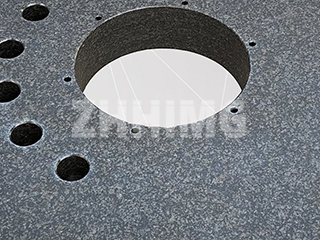In ultra-precision environments—from semiconductor fabrication to advanced metrology laboratories—the granite machine base serves as the critical reference plane. Unlike decorative countertops, industrial granite bases, such as those manufactured by ZHONGHUI Group (ZHHIMG®), are precision instruments. Proper maintenance and cleaning are not merely about aesthetics; they are essential procedures for preserving nanometer-level accuracy and ensuring equipment longevity.
A comprehensive understanding of stain types and their removal is required to avoid compromising the base’s surface integrity.
Understanding the Enemy: Industrial Contaminants
Before initiating any cleaning process, it is paramount to identify the nature of the contaminant. While household stains might include wine or coffee, a precision granite base is more susceptible to cutting fluids, hydraulic oils, calibration waxes, and coolant residues. The method of cleaning must be tailored to the specific chemical composition of the stain to prevent penetration or surface damage.
The initial step should always involve a gentle clearing of the surface using a soft, dry cloth or a specialized particle vacuum to remove abrasive dust or debris. Once the surface is clear, a careful assessment of the residue dictates the appropriate course of action. It is always best practice to perform a small-area test on an inconspicuous spot of the granite to confirm the cleaner’s compatibility before treating the main working area.
Targeted Cleaning for Precision Environments
For industrial applications, the choice of cleaning agent is critical. We must avoid anything that can leave a film, cause thermal shock, or lead to corrosion of adjacent components.
Oil and Coolant Residues: These are the most common industrial contaminants. They must be tackled using a neutral pH detergent specifically formulated for stone, or a certified granite surface plate cleaner. The cleaner should be diluted according to manufacturer instructions, applied minimally to a soft, lint-free cloth, and used to gently wipe the affected area. It is crucial to rinse the area thoroughly and immediately with clean water (or alcohol, to accelerate drying) to prevent any residue film that could attract dust and accelerate wear. Avoid acidic or alkaline chemicals at all costs, as they can etch the fine finish of the granite.
Rust Stains: Rust, typically originating from tools or fixtures left on the surface, requires careful handling. A commercial stone rust remover can be applied, but this process demands great caution. The product must be specifically designed for stone, as generic rust removers often contain harsh acids that will severely damage the granite finish. The remover should be allowed to sit briefly, wiped clean with a soft cloth, and thoroughly rinsed.
Pigments, Paint, or Gasket Adhesives: These often require a specialized stone poultice or solvent. The material should first be gently scraped or lifted from the surface using a plastic scraper or clean, soft cloth. A small amount of the solvent can then be applied. For stubborn, cured materials, multiple applications may be necessary, but extreme care must be taken to ensure the solvent does not compromise the granite surface.
Technical Recommendations and Long-Term Preservation
Maintaining a precision granite machine base is an ongoing commitment to geometric integrity.
The primary objective after cleaning is to ensure the surface is completely dry. Excessive residual moisture, especially from water-based cleaners, can slightly alter the granite’s thermal characteristics or cause rusting on any adjacent metal components. This is why professionals often favor isopropanol or specialized low-evaporation surface plate cleaners.
For highly persistent or widespread contamination, seeking technical stone cleaning services is always the most advisable course. Specialists possess the experience and equipment to restore a base’s geometric integrity without causing microscopic damage.
Finally, regular preventative maintenance extends the base’s lifespan indefinitely. Stains should be addressed immediately upon discovery before they have time to penetrate the stone’s pores. When the granite base is not in use, it must remain covered with a protective layer to shield it from airborne debris and temperature fluctuations. By treating the granite base as the ultra-precise instrument it is, we safeguard the stability and accuracy of the entire machine built upon the ZHHIMG® foundation.
Post time: Oct-30-2025

